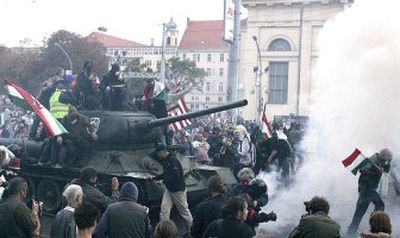Violence racks Budapest

BUDAPEST, Hungary – Police fired rubber bullets, tear gas and water cannons to disperse thousands of anti-government demonstrators who later hijacked two unarmed tanks in violence that marred the 50th anniversary of Hungary’s uprising against Soviet rule.
At least 40 people, including some police, were injured, rescue officials said. State news agency MTI reported that police beat some of the protesters – including women and elderly people – with rubber batons, and some had head injuries.
In one of the main showdowns on Monday near Deak Square, the city’s main subway hub, hundreds of police behind three water cannons slowly advanced on a few hundred rioters. The protesters threw bottles and rocks at the police who fired tear gas and rubber bullets back at them as a police helicopter circled low above the crowd.
Then one of the protesters seized a tank that was part of an exhibit in the square to commemorate the revolution. He drove it among the protesters until he was pulled out by police who rushed the vehicle. A second tank in the exhibit was pushed by the rioters toward the police.
The tanks were powerful symbols of the 1956 revolt. The night the uprising began, Red Army tanks rolled through the streets of Budapest, and 12 days later, a blitz led by 4,500 Soviet tanks overran the country.
Most of the protesters were peacefully demanding to be allowed back to Kossuth Square outside parliament where the main commemorations of the 1956 revolution were under way.
Anti-government protests have been going on since Sept. 17, when Socialist Prime Minister Ferenc Gyurcsany was heard admitting on a leaked recording that the government had lied about the economy before winning re-election in April.
On Monday, the protesters had gathered in different spots near the center of the city. Some had set up roadblocks with garbage cans and threw rocks at police dressed in riot gear, who used tear gas and water cannons to disperse them near St. Stephen’s Basilica.
Delegations from at least 56 countries were in Budapest for Monday’s commemorations, including NATO Secretary-General Jaap de Hoop Scheffer and Spain’s King Juan Carlos. The ceremonies included Hungarian and foreign dignitaries laying flowers at the foot of a 1956 monument on Kossuth Square.
The 1956 student protests began on the afternoon of Oct. 23 and by nightfall had turned into an armed uprising. Around 2,800 Hungarians and 700 Soviet troops were killed in the Red Army offensive to crush the revolt, which was launched on Nov. 4, 1956.